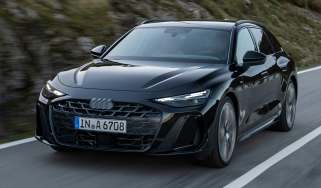Ford Focus Estate - Engines, drive & performance
Ford Focus Estate drivers wouldn't know they were behind the wheel of anything so practical
Driver appeal doesn't naturally figure high on family estate cars' 'must-have' lists, but models like the SEAT Leon estate have proven that practicality and handling prowess needn't be mutually exclusive. Fortunately – as with its hatchback sister – the latest Ford Focus Estate offers a sharper and more involving drive than its predecessor.
Based on an all-new 'C2' platform that'll also underpin future models of other cars in the Ford range, the latest Focus was designed to appeal to enthusiastic drivers from the outset. Body stiffness is said to be far greater than previous Focus models, so the suspension has to do less work to keep the car composed.
The extra £1,000 for the Focus Estate doesn’t just get you more space than the hatchback, it actually has more sophisticated suspension than the entry-level model, too. All Focus Estate cars get fully-independent rear suspension like that used by the sporty Focus ST-Line; this provides much greater refinement and stability than the old-fashioned torsion-beam setup that comes as standard on the hatchback model.
No matter whether you choose the hatchback or the estate, all Ford Focus models come with electric power steering that’s designed to offer plenty of feedback on twisty roads. Furthermore, the traction control incorporates 'torque steer compensation' and torque-vectoring control to make sure power is deployed in such a way as to avoid unwanted steering movements.
More reviews
What this all amounts to is an estate car that feels barely any different to the smaller hatchback from behind the wheel – good news, because the Focus is one of the very best handling family cars you can buy. That clever steering is responsive and feels natural, while the whole car feels very well balanced, as well as eager to tackle corners. The ST-Line sits 10mm lower than other models and feels a little sportier as a result, whereas the Active model rides 30mm higher. While this certainly gives a commanding driving position akin to a proper SUV, don’t expect the front-wheel-drive Focus to be any use off-road.
Ford Focus Estate petrol engines
Ford’s 1.0-litre Ecoboost engine has been praised for its perfect blend of performance and efficiency and can be found in several of the brand’s most popular models such as the Fiesta and the Puma.
In the latest Focus, buyers specify this engine in two power outputs: 123bhp and 153bhp. The former can get from 0-62mph in 10.3 seconds, whereas the added power of the latter brings this time down to just 9.4 seconds.
No matter which power output you choose, the petrol Focus feels suitably punchy, and the rather coarse engine note adds to the car’s sporty character. If you plan to be hauling cargo frequently, we’d suggest opting for the more powerful engine as the 123bhp unit could start to struggle with a heavy load.
For the first time, both setups are available with mild-hybrid assistance for added efficiency. The lower-powered mild-hybrid comes as standard with a seven-speed automatic gearbox, while the 153bhp car can be specified with an auto or a slick six-speed manual transmission. Ford also offers the 123bhp petrol engine with no mild-hybrid assistance; this comes as standard with the manual gearbox and is slightly cheaper to buy.
Topping the Focus Estate lineup is the high-performance ST model. This uses a powerful 2.3-litre four-cylinder engine with 276bhp and can sprint from 0-62mph in just 5.8 seconds. We’ve reviewed that car separately here.
Diesel engine
As with the hatchback, Ford now only offers one diesel engine for the Focus: a 1.5-litre four-cylinder EcoBlue unit. With just 118bhp at its disposal, this gets from 0-62mph in 10.3 seconds – however, it feels much faster at slower speeds due to having plenty of torque. Buyers can choose from either a six-speed manual or an eight-speed automatic gearbox.
Which Is Best?
Cheapest
- Name1.0 EcoBoost Hybrid mHEV Titanium 5dr
- Gearbox typeManual
- RRP£29,660
Most Economical
- Name1.0 EcoBoost Hybrid mHEV Titanium 5dr
- Gearbox typeManual
- RRP£29,660
Fastest
- Name2.3 EcoBoost ST 5dr Auto
- Gearbox typeAuto
- RRP£40,455















